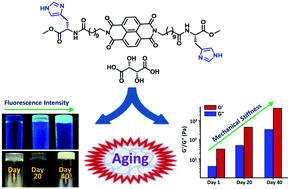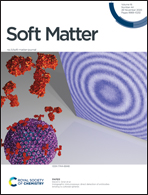The aging effect on the enhancement of thermal stability, mechanical stiffness and fluorescence properties of histidine-appended naphthalenediimide based two-component hydrogels†
Abstract
A histidine attached naphthalenediimide (NDI)-containing amphiphilic molecule (NDIP) self-assembles into nanotubes in aqueous solution at pH 6.6 as revealed by high-resolution transmission electron microscopy studies. This histidine-appended NDI forms a two-component hydrogel in the presence of tartaric acid at a molar ratio of 1 : 2. A morphological transformation was observed from a nanotube structure in the non-gel aggregated state of histidine appended NDI to interconnected cross-linked nanofibers of the two-component hydrogel in the presence of tartaric acid. Interestingly, the gel exhibits an unusual behavior upon aging compared to the fresh gel. It is found that the thermal stability and gel stiffness increase very significantly upon aging. Another important feature noted is that the very weak fluorescence of the fresh gel is transformed into bright greenish fluorescence upon aging. These results suggest that intermolecular interactions among the gelator molecules and tartaric acid in the gel phase slowly increase with time to form a mechanically very stiff and thermally robust gel.

- This article is part of the themed collection: Peptide Soft Materials


 Please wait while we load your content...
Please wait while we load your content...